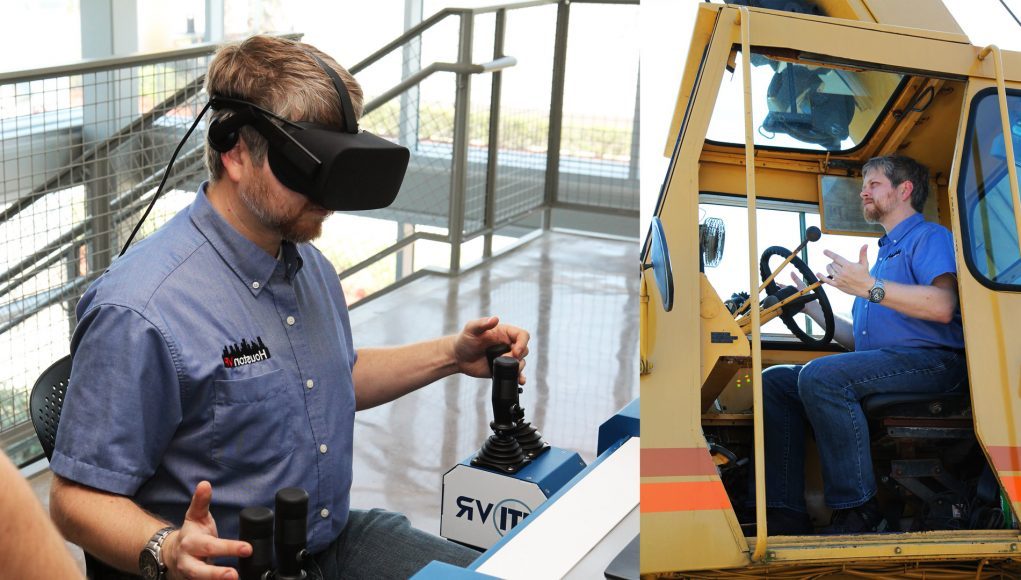Last week, I traveled to the Houston Area Safety Council in Pasadena, Texas, to put Industrial Training International VR’s new crane simulator through its paces. While ITI has been training crane operators, riggers, and signallers for 30 years, the inclusion of VR in their training programs is a recent development. To test the effectiveness of their VR crane simulator ITI offered to let me—someone who has never operated heavy machinery in their life—spend an hour training with the system and then apply what I learned to operating an actual crane.
Guest Article by Eric Liga
 Eric is the co-founder and co-organizer of the HoustonVR Meetup, and an event manager for the Immersive Technology Conference. He was the VR technical adviser for the VR Pain and Anxiety Management pilot program at Memorial Hermann Prevention and Recovery Center, and has been actively involved in the VR scene since the 2012 Oculus Kickstarter. He has been a professional computer programmer for over 20 years.
Eric is the co-founder and co-organizer of the HoustonVR Meetup, and an event manager for the Immersive Technology Conference. He was the VR technical adviser for the VR Pain and Anxiety Management pilot program at Memorial Hermann Prevention and Recovery Center, and has been actively involved in the VR scene since the 2012 Oculus Kickstarter. He has been a professional computer programmer for over 20 years.
Unlike traditional simulators, which physically replicate a crane’s cab, surrounded by oversized monitors, ITI’s VR crane simulator is compact and rather modest looking. A laptop outfitted with a GTX 1070 drives output to an Oculus Rift, and a metal bracket with four joysticks (interchangeable to match a range of crane brands and models) attaches to any available table using a pair of clamps. The simulator weighs 30 lbs and packs neatly into a rolling Pelican case (at a total of 68lbs) for transport, making it reasonable to take the simulator to on-site locations for training or evaluation of job candidates.
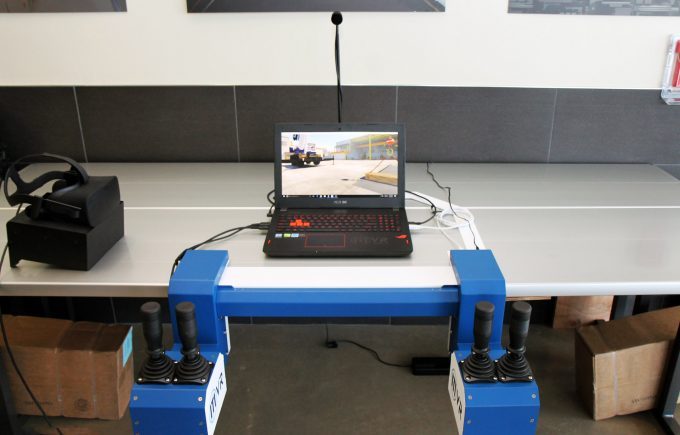 ITI plans to sell the hardware elements of its crane simulator at-cost (a fraction of the $100k starting price of most traditional crane simulators), plus a yearly software license fee. Access to upcoming features, including new types of cranes (such as Overhead Cranes) and multi-user scenarios, is included in the licensing cost. Simulators will allow networking to support scenarios with multi-crane lifts and integrated training of signal people outfitted with VR hand-trackers.
ITI plans to sell the hardware elements of its crane simulator at-cost (a fraction of the $100k starting price of most traditional crane simulators), plus a yearly software license fee. Access to upcoming features, including new types of cranes (such as Overhead Cranes) and multi-user scenarios, is included in the licensing cost. Simulators will allow networking to support scenarios with multi-crane lifts and integrated training of signal people outfitted with VR hand-trackers.
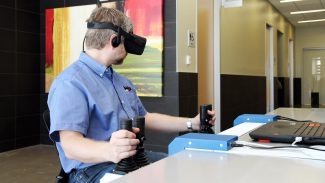 If haptic feedback is desired, the “Motion Base” model of the simulator includes a platform with hydraulic lifts at each corner and bass transducers to simulate engine rumble. This version of the simulator wasn’t available to demo, but I tested an equivalent base integrated into ITI’s Aerial Work Platform simulator. In that capacity, it did a fine job of adding to the sensation of “actually being there.” At 400 lbs, the inclusion of the base would negate many of the simulator’s advantages in compactness and portability, but in a permanent installation, it could add nicely to the experience.
If haptic feedback is desired, the “Motion Base” model of the simulator includes a platform with hydraulic lifts at each corner and bass transducers to simulate engine rumble. This version of the simulator wasn’t available to demo, but I tested an equivalent base integrated into ITI’s Aerial Work Platform simulator. In that capacity, it did a fine job of adding to the sensation of “actually being there.” At 400 lbs, the inclusion of the base would negate many of the simulator’s advantages in compactness and portability, but in a permanent installation, it could add nicely to the experience.
Paired with a monitor instead of a VR HMD, the simulator was functional, if unexceptional. Adding in the VR headset, however, moved the experience into a different category. The addition of depth perception made understanding the motion of the crane’s distant chain far easier, and being able to glance up to check the boom tip, or lean around to check mirrors made the experience much more comparable to actually operating a crane.
Having never operated a crane before, let alone any type of heavy machinery, a number of the required skills turned out to be neither easy nor intuitive for me, and my initial forays in the simulator were less than promising. Suspended loads swung perilously close to signalmen or knocked over boxes and barrels. Virtual overseers chided me for taking too long or setting down loads too hard. By this point, Caleb Steinborn, ITI’s Product Manager of VR Simulations, may have begun to regret ever offering to let me operate a real 22 ton crane after the VR training.
One challenge for me was “booming up and lowering the load.” This involved maintaining the cargo at a set height while angling the boom arm up. Imagine the motion of a lure at the end of a fishing line: when you angle the fishing pole up, the dangling lure moves up with it. On a crane, an operator must extend the chain (hoist) at the same rate as the boom would be raising it, to keep the load level while maneuvering the boom at the same time. This may also need to be done while rotating the boom, in which case the operator must manage two joysticks with one hand and a third joystick with the other.
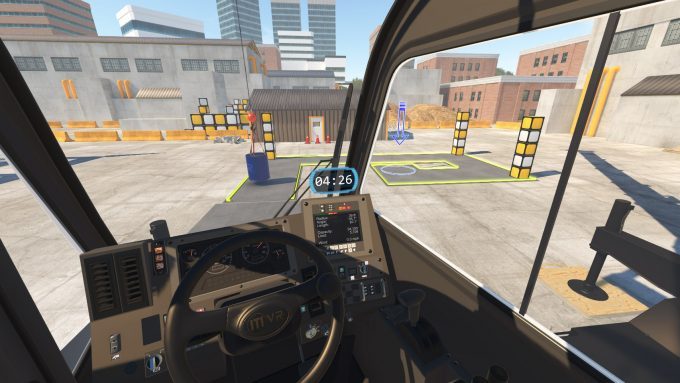 Another task, even more challenging for me, was “catching the swing.” Once the crane arm stops moving, momentum will cause the suspended load to continue on its path, setting the chain into a 1 or 2-axis swing. To stabilize the load, the crane operator must then move the boom arm to follow the load’s center of gravity, overshooting slightly at the end of the swing in each direction, to compensate for momentum and keep the load stable.
Another task, even more challenging for me, was “catching the swing.” Once the crane arm stops moving, momentum will cause the suspended load to continue on its path, setting the chain into a 1 or 2-axis swing. To stabilize the load, the crane operator must then move the boom arm to follow the load’s center of gravity, overshooting slightly at the end of the swing in each direction, to compensate for momentum and keep the load stable.
While the simulator’s full training sequence includes over 18 hours of content, I only sampled one or two scenarios from each unit, completing a heavily abbreviated course in just under an hour. The final test, a simulation of the National Commission for the Certification of Crane Operators Z-Corridor Practical Exam, required me to guide a suspended barrel through a zig-zag corridor lined with tennis balls balanced on poles. Knock a ball off of a pole? You fail the test. Bump the ground with the barrel, or raise it higher than the short length of chain trailing below it? You fail the test. Take longer than 4 minutes to complete the task? Fail.
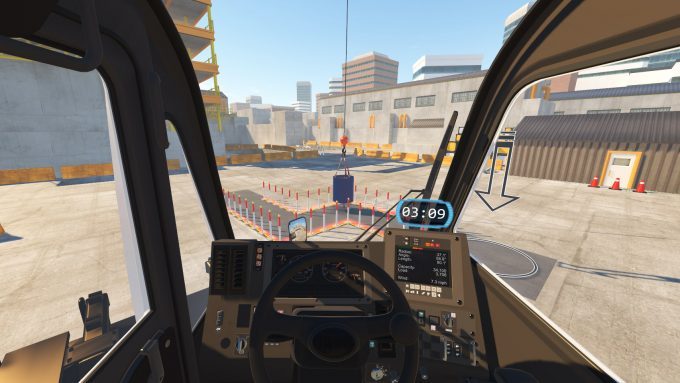 Did I pass? Well… no. I did make it perhaps three quarters of the way through the course before failing, though. This seemed to satisfy the training supervisor that I could perform some basic operations on a real crane—under supervision—safely. So after some hurried consultation with the higher-ups at HASC, our small group was loaded into a golf cart and whisked out to meet the 22 tons of yellow-painted metal which I would now attempt to operate.
Did I pass? Well… no. I did make it perhaps three quarters of the way through the course before failing, though. This seemed to satisfy the training supervisor that I could perform some basic operations on a real crane—under supervision—safely. So after some hurried consultation with the higher-ups at HASC, our small group was loaded into a golf cart and whisked out to meet the 22 tons of yellow-painted metal which I would now attempt to operate.
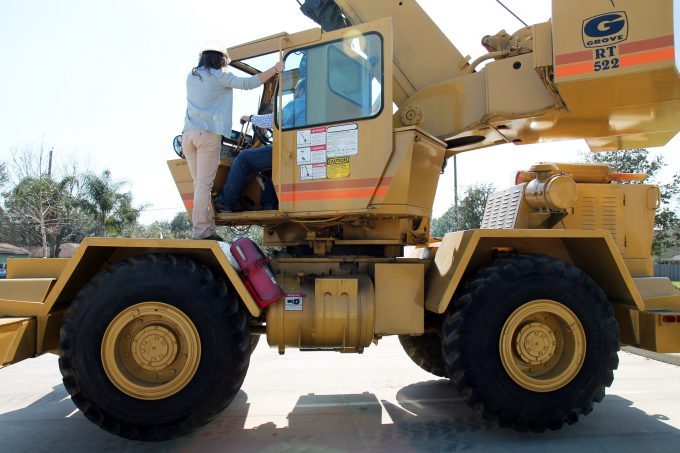 Rather nervously, I climbed up onto the crane, clambered awkwardly into the cab, and listened as Amanda Jordan, the ITI Houston Branch Regional Director, gave me a run-down of the this specific crane’s control scheme. Within a minute or two, I had adapted to the new set of levers and pedals and had the “headache ball” crane hook at the end of the hoist gliding in various directions around the testing area.
Rather nervously, I climbed up onto the crane, clambered awkwardly into the cab, and listened as Amanda Jordan, the ITI Houston Branch Regional Director, gave me a run-down of the this specific crane’s control scheme. Within a minute or two, I had adapted to the new set of levers and pedals and had the “headache ball” crane hook at the end of the hoist gliding in various directions around the testing area.
Could I “boom up and lower the load”? Yes.
Could I “catch the swing”? Yes.
 Could I maneuver a suspended barrel through a tricky obstacle course? Well… probably not. And I didn’t try. But I did feel confident that more time spent in the simulator would bring my abilities up to snuff. And the simulator did a superb job of replicating the experience of operating an actual crane—an assessment which appeared to be shared by a handful of crane operators and trainers we convinced to stop in for a moment to run through a test scenario or two.
Could I maneuver a suspended barrel through a tricky obstacle course? Well… probably not. And I didn’t try. But I did feel confident that more time spent in the simulator would bring my abilities up to snuff. And the simulator did a superb job of replicating the experience of operating an actual crane—an assessment which appeared to be shared by a handful of crane operators and trainers we convinced to stop in for a moment to run through a test scenario or two.
It’s worth noting that ITI’s development partner, Edmonton-based Serious Labs, took the software side of ITI’s crane simulator from concept to final product in 8 months. Doubtless, this was aided by the ability to reuse assets from other simulators (the Aerial Work Platform simulator shared much of the same environment), but the end result was impressive nonetheless.
ITI’s VR crane simulator will officially debut at ConExpo in Las Vegas and will begin shipping to clients in the latter half of March.
Photography by William Golden, Director of the Immersive Technology Conference.

